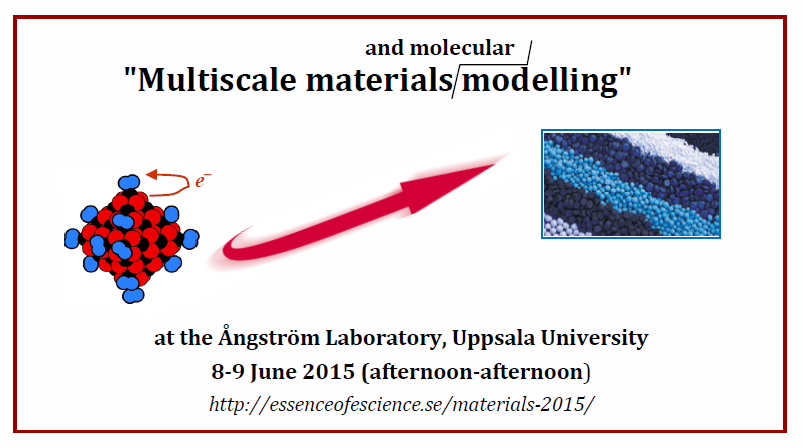Update (5 June) : Program
To push the boundaries of e-science closer to realistic applications, and to improve our understanding of chemical and physical phenomena, development of methods and models at all levels is needed. Not least, we must find ways to combine methods in a powerful yet feasible way, and learn how to smoothly move up and down the multiscale ladder. The national e-science programme eSSENCE – where Uppsala University, Lund University and Umeå University are partners – now welcomes you to discuss methods/models and modelling applications at this fourth national meeting on multiscale materials modelling.
Colleagues from our national sister program SeRC, from the Chalmers e-science initiative as well as all other e-science actors or interested colleagues are warmly welcome to participate. Senior researchers, postdocs and PhD students are all equally welcome.
We use the word “materials” in a broad sense, including molecules, liquids and interfaces, and even fish.

Program:
Monday 8 June
| 13.00-13.10 | Kersti Hermansson | Welcome and Introduction |
| Session 1: “From fine-grained …” Chair: Hans Ågren (KTH) | ||
| 13.10-14.00 | Keynote talk: Lars Ojamäe (LiU) |
“Modelling at the electronic and atomistic scales: From water clusters to inorganic materials“ |
| 14.00-14.30 | Per Hyldgaard (CTH) | “Role of spin in the Van der Waals density functional “ |
| 14.30-15.00 | Anders Bergman (UU) | “Modelling chiral magnets – from individual atoms to collective excitations“ |
| 15.00-15.20 | Joakim Halldin Stenlid (KTH) | “On the origin of hydrogen gas evolution from copper in anoxic water“ |
| 15.20-15.45 | Coffee | |
| Session 2: ” ..to more coarse-grained and large-scale” Chair: Olle Eriksson (UU) | ||
| 15.45-16.35 | Keynote talk: Pietro Asinari (Torino) |
“Modelling beyond the atomistic scale: From molecular interfaces to open issues in renewable energy engineering“ |
| 16.35-17.05 | Jolla Kullgren (UU) | “Parameterized methods for accurate simulations of metal oxide surfaces“ |
| 17.05-17.25 | Björn Dahlgren (KTH) | “Modelling interfacial radiation chemistry without explicit atoms or electrons“ |
| 17.25-17.45 | Jacinto Sa (UU) | “Shining light into chemistry’s dark secrets: from experiment to theory“ |
| Session 3: “Poster session – oral & traditional” Chairs: Ali Rafieefar, Dou Du, Getachew Kebede (UU) | ||
| 17.45-18.30 | 5 min break, and then Oral POSTER presentations | |
| 18.30-19.30 | Poster session & mingel | |
| 19.30- | Buffet at the Café Ångström | |
Tuesday 9 June
| Session 4: “Dynamics” Chair: Magnus Ullner (LU) | ||
| 09.00-09.50 | Keynote talk: David Sumpter (UU) |
“The principles of collective fish behaviour – are there similarities to molecular dynamics? |
| 09.50-10.20 | Joakim Stenhammar (LU) | “Phase behaviour of active Brownian particles“ |
| 10.20-10.40 | Håkan Hugosson (KTH) | “Quantum Molecular Dynamics studies of polymer-based thermoelectric materials“ |
| 10.40-11.10 | Coffee | |
| Session 5: “Modelling challenges of biosystems” Chair: Peter Broqvist (UU) | ||
| 11.10-12.00 | Keynote talk: Per Siegbahn (SU) |
“How to solve an important chemical problem for a large system by quantum chemical methods: The case of oxygen formation in photosynthesis“ |
| 12.00-12.30 | Murugan Arul (KTH) | “Multiscale modeling approaches for Diagnostic Probes Design” |
| 12.30-13.30 | Lunch | |
| Session 6: “Biosystems II” Chair: Mårten Ahlqvist (KTH) | ||
| 13.30-13.50 | Ingela Nyström | “The eSSENCE program“ |
| 13.50-14.20 | Fernanda Duarte (UU) | “Understanding Functional Evolution in the Alkaline Phosphatase Superfamily“ |
| 14.20-14.40 | Xianqiang Sun (KTH) | “Theoretical Studies of G-Protein-Coupled Receptors“ |
| 14.40-15.00 | Stefan Knippenberg (KTH) | “An exploration of ADC data to describe non-linear properties of cyanine molecules“ |
| 15.00-15.30 | Discussion – what do we need? (Kersti Hermansson) | |
Poster presentations
| Abas | Mohsenzadeh Syouki | “The water gas shift reaction on nickel facets: A comparative DFT study“ |
| Rafael | Couto | “Resonant Inelastic X-ray Scattering of gas phase water“ |
| Ignat | Harczuk | “Generalized Frequency Dependent Polarizabilities and Hyperpolarizabilities in Extended Molecular Mechanical Systems“ |
| Rocio | Marcos | “Theoretical investigation of the iron-catalyzed hydrogenation of bicarbonated to formate“ |
| Amina | Mirsakiyeva | “Quantum Molecular Dynamics Studies of Thermoelectric Polymer Systems“ |
| Daniel | Mårtensson | “Molecular Dynamics Investigations of Water Oxidation I2M Reaction“ |
| Yan | Wang | “Molecular Adhesion at Clay Nanocomposite Interfaces Depends on Counterion Hydration – Molecular Dynamics Simulation of Montmorillonite/Xyloglucan“ |
| Dou | Du | “Oxygen Storage in Nanoceria: A Revisit by Employing Hybrid Density Functionals“ |
| Erik | Källman | “Quantum chemical tools for orbital-specific interpretation of x-ray processes“ |
| Esko | Makkonen | “Theoretical study of water-oxidizing complexes with iron center“ |
| Anik | Sen | “Computational Crystallography of water“ |
| Matthew | Wolf | “Formation of superoxides at fluorine doped ceria surface facets“ |
| Changgang | Xu | “Purification and quantification of antibody IgG with DNA-nanocellulose composite membrane“ |
| Getachew | Kebede | “A Van der Waals density functional study on the structure and energetics of H2O/NaCl(100) and H2O/MgO(100) interfaces“ |
Additional information (transportation, maps, etc.) concerning Uppsala and the meeting can be found here.
We hope you want to participate and contribute with your scientific input !
VERY WELCOME!
Kersti Hermansson and co-organizers
kersti@kemi.uu.se
Tel 018-4713767